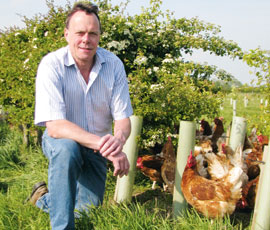Planting trees for better ranging

Native trees and shrubs are the most popular with free-range egg producers, although conifers can work just as well and provide year-round cover, says Richard Padgett of Yorkshire firm Thorpe Trees.
Most planting arrangements for poultry enterprises are based on a series of hedges or spurs close to the birds’ housing, he explains. These lead the birds towards the edge of the range, which contains trees and shrubs arranged in groups.
An area covering 4ha would normally include some 10-15 groups of trees and shrubs, each containing between 50 and 200 individual plants. Arranging the plants in clumps, with 5-10 of the same species, will give a visual effect similar to natural woodland, and should provide shade and shelter for the hens within three to four years.
Hedge plants are best planted in double-staggered rows, advises Mr Padgett, to increase the density of the cover, while allowing more space for them to grow. The inclusion of species such as willows and poplars is important, because they are fast growing and help to establish early cover, he adds.
The general advice is to plant trees leaving 4m between rows, for easy access. However producers may need to allow more, depending on the grass topping machinery available; a unit with a 4m topper will need 4.25m rows, for example.
Increasing the spacing between rows close to the outer edge will create a “feathered” appearance. Care should also be taken, to plant trees within the rows roughly 2.5m apart, to promote vertical growth.
Most species of bare-rooted (non-containerised) trees should be planted during the dormant period, from late October until the end of March. The soil should be moist and friable to achieve the best result.
After planting, the main task is to protect the young plants in the first few years. Trees and shrubs should be encased in a tube, minimum 60cm high, with a treated wooden stake to keep them in place.
To discourage competition from weeds, it is advisable to spray the area within 30cm of the base of the plant with a standard herbicide. This is best carried out between flocks if possible, or during the spring.
Case study
Phil Twizell, West Newbiggin Farm, Sadberge, County Durham
Mr Twizell set up a free-range egg production and packing unit on his farm in 2009, following the sale of his pig herd. The majority of his production goes to Chippindale Foods, but he also markets his own-branded “Phil Twizell” eggs, which are sold direct to local hotels and restaurants.
The eggs are produced to the RSPCA’s Freedom Food standards, which require the range to contain a percentage of natural cover. However, Mr Twizell exceeded the standard requirements when Thorpe Trees carried out his planting in spring, 2010, as he is keen to encourage the hens to make full use of the area available.
The 16,000 Lohmann Brown layers are housed in one multi-tier unit, with the range split into four paddocks, each measuring around five acres.
The planting scheme, developed by an expert from FWAG (Farming and Wildlife Advisory Group), incorporated a mixture of 4,000 trees, hedgerow plants and shrubs. Mr Twizell has also installed a number of field covers, to enhance the range until the plants are fully established. Around 275 trees which did not survive year one have had to be replaced.
“The project was fairly time-consuming during the first phase, because the plants will not do well unless they receive some attention. Watering was necessary in dry spells during the first year, and weeds had to be kept under control,” he says. “I had not imagined that it would take up quite so many hours, but hopefully the planting will be relatively maintenance free from this year onwards.
“The main lesson I have learned is to avoid planting trees too close together, and too close to the boundary fencing. It causes access problems for the mechanical topper.”
West Newbiggin Farm planting stock
• Major trees – 60% including Ash, Birch and Rowan
• Minor trees – 10% including Oak, Elm, Cherry, and Alder
• Shrubs – 10% including Hazel, Hawthorn, and Willow
• Fast-growing species – 16% of Hybrid Poplar and Willow
• Conifers – 4% including Scots Pine & Norway Spruce
Range Enrichment Scheme
Mr Twizell’s free-range unit meets the requirements of Morrisons supermarket’s Range Enrichment scheme. The majority of his production is sold under their Nature’s Nest brand via the packer, Chippindale Foods of Harrogate. The scheme aims to encourage members to provide cover over a target area of 20% of the range. Planting plans are based on native, broad-leaved tree species, and designed to complement the wildlife habitat in the surrounding area.
David Hilldrith, contracted production manager for Chippindale foods, is encouraging new and existing producers to adopt this practice to increase the marketability of their eggs in an increasingly competitive market. Encouraging the birds to range away from the unit will reduce disease risk and significantly improve bird welfare, he says.
